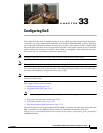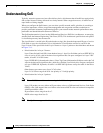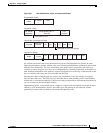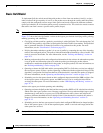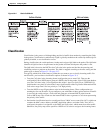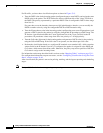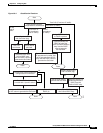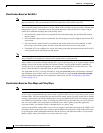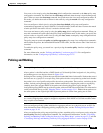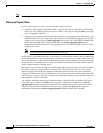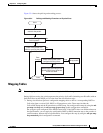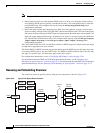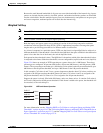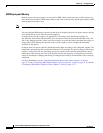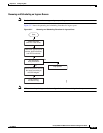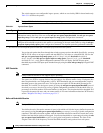
33-9
Catalyst 2960 and 2960-S Switch Software Configuration Guide
OL-8603-09
Chapter 33 Configuring QoS
Understanding QoS
You create a class map by using the class-map global configuration command or the class policy-map
configuration command. You should use the class-map command when the map is shared among many
ports. When you enter the class-map command, the switch enters the class-map configuration mode. In
this mode, you define the match criterion for the traffic by using the match class-map configuration
command.
You can configure a default class by using the class class-default policy-map configuration
command(not supported on Catalyst 2960-S). Unclassified traffic (traffic that does not meet the match
criteria specified in the traffic classes) is treated as default traffic.
You create and name a policy map by using the policy-map global configuration command. When you
enter this command, the switch enters the policy-map configuration mode. In this mode, you specify the
actions to take on a specific traffic class by using the class, trust, or set policy-map configuration and
policy-map class configuration commands.
The policy map can contain the police and police aggregate policy-map class configuration commands,
which define the policer, the bandwidth limitations of the traffic, and the action to take if the limits are
exceeded.
To enable the policy map, you attach it to a port by using the service-policy interface configuration
command.
For more information, see the “Policing and Marking” section on page 33-9. For configuration
information, see the “Configuring a QoS Policy” section on page 33-47.
Policing and Marking
Note To use policing and marking, the switch must be running the LAN Base image.
After a packet is classified and has a DSCP-based or CoS-based QoS label assigned to it, the policing
and marking process can begin as shown in Figure 33-4.
Policing involves creating a policer that specifies the bandwidth limits for the traffic. Packets that exceed
the limits are out of profile or nonconforming. Each policer decides on a packet-by-packet basis whether
the packet is in or out of profile and specifies the actions on the packet. These actions, carried out by the
marker, include passing through the packet without modification, dropping the packet, or modifying
(marking down) the assigned DSCP of the packet and allowing the packet to pass through. The
configurable policed-DSCP map provides the packet with a new DSCP-based QoS label. For information
on the policed-DSCP map, see the “Mapping Tables” section on page 33-11. Marked-down packets use
the same queues as the original QoS label to prevent packets in a flow from getting out of order.
Note All traffic, regardless of whether it is bridged or routed, is subjected to a policer, if one is configured.
As a result, bridged packets might be dropped or might have their DSCP or CoS fields modified when
they are policed and marked.
You can configure policing (either individual or aggregate policers) on a physical port or an SVI. For
more information about configuring policing on physical ports, see the “Policing on Physical Ports”
section on page 33-10.
After you configure the policy map and policing actions, attach the policy to an ingress port by using the
service-policy interface configuration command. For configuration information, see the “Classifying,
Policing, and Marking Traffic on Physical Ports by Using Policy Maps” section on page 33-53 and the
“Classifying, Policing, and Marking Traffic by Using Aggregate Policers” section on page 33-58.



